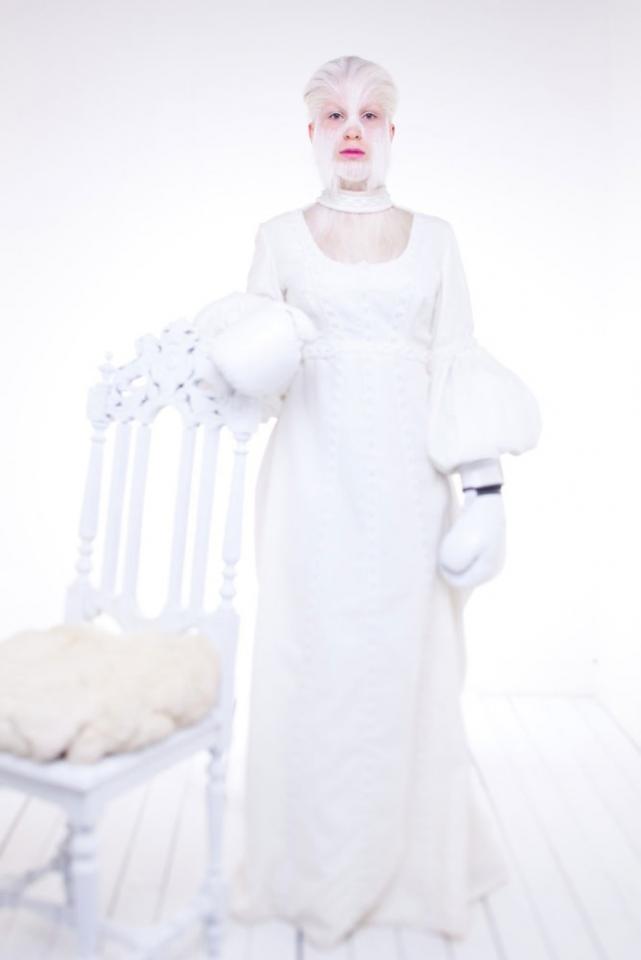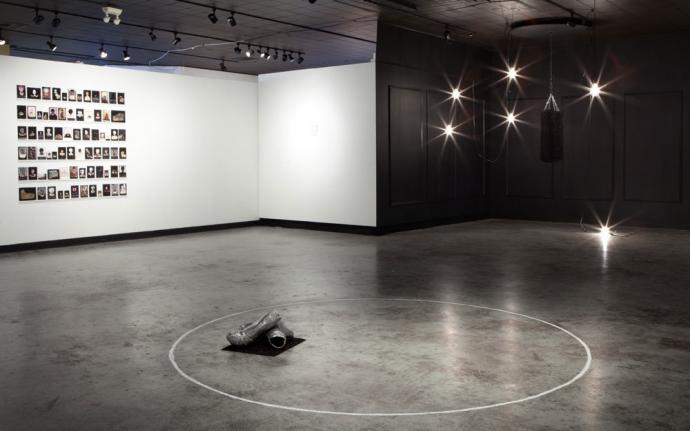from pastelegram.org, June 2011 – April 2014
Margaret Meehan: Hystrionics and the Forgotten Arm
Part back alley brawl and Victorian-infused spectacle, Margaret Meehan’s Hystrionics and the Forgotten Arm touches upon identity, observation and performance. Appropriating the vocabulary and aesthetics of pugilism, Meehan unveils a multimedia sensorial experience using photographs, mixed media works, sculpture-based installations and sound.
Upon entering Hystrionics, the photograph The Journeyman elicits the first altercation. A bold-faced stare by the unnamed albino figure suffering from hypertrichosis—excessive hair growth—recalls promotional fight posters. Almost equivalent and at times more excessive than the match itself is the publicity and pre-fight poster, usually with one or more fighters showcasing their physique and athletic grandeur in a combative stance. Meehan’s albino fighter stands with a similar self-aggrandizing pose; however, Meehan alters the association of the historical “freak” and its role with the viewer in The Journeyman. Here the “freak” is still a showcase for a leering viewer but is an object of both disgust and desire. The artist’s addition of the boxing gloves on the figure evolves the relationship between onlookers with an implied possibility of a violent response; this “freak” can be looked at but might hit back.

Meehan’s albino pugilist photographs are spread throughout the gallery and carry a sequence: from the initial Journeyman, to the bloodied close-up in Lacing, to the final action shot in Jab. Each photograph pictures the albino boxer amongst a white unknown with portions of the surrounding scene blurred. Accentuating the dizziness and affect of pain or creating a chimera of wonderment, Meehan’s photographs literally blur the line of reality within the confines of the composition.
The overall exhibition layout supports Hystrionics’ evident motivations in recreating not only a boxing ring but the atmospheric attributes of spectacle. The accompanying list of works indicates a counterclockwise viewing; even the viewer’s footwork is subject to Meehan’s meticulous choreography. The works Rope a Dope, Glass Jaw, and The Circled Square effectively experiment with the appropriated boxing equipment and develop episodic spaces.

Set in the corner, Rope a Dope is an oversized set of six velvet-encased bands stretched across two walls. The bands are not the taut ropes of the boxing ring; they sag, becoming rather depressed and removed components. Meehan releases the ropes from their original objectives as demarcations of space or partitions and formalizes them to ornamental accoutrements. Parallel to this spatial reference is The Circled Square. The simplistic circle drawn in oil stick references the throwback boxing ring, and within its confines Meehan carefully asserts the contemporary with the inclusion of aluminum cast gloves atop a glittered square. It is with the Glass Jaw installation that Meehan clearly excels at expounding on the characteristic of boxing as a temporal space and spectacle. Against a black backdrop with intervals of hanging spotlights and a brilliant punching bag Meehan elevates the preparatory stage of the gym to glitterati-infused pageantry.
The absence of a figure in these works evokes a phantasmic quality that elucidates a reaction. Without direct provocation from a human figure, the ornamentation and reconfiguring of the sculptural installations and spaces fabricate remnants of implied physical force that has been exerted against the objects or the precursor of such actions. Yet Meehan’s feminization of these spaces, with the bowed ends in Rope a Dope, the glittered detailing of the punching bag within Glass Jaw and the brilliance of the gloves carefully placed in The Circled Square accentuates public spectacle’s ostentatious nature. With these carefully detailed supplementary accents, the formerly abject elevates to the extraordinary and there is an acquiescence of not only empathy, but reverence for Hystrionics’ “monsters.”